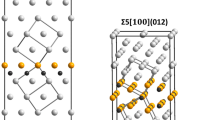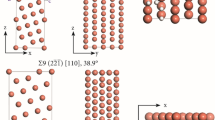Abstract
Atomistic simulations performed for the hydrogen segregation in different Ni \( \Sigma 3 \) 〈110〉 tilt grain boundaries (GBs), including symmetrical and asymmetrical configurations, highlight a decreasing functional relationship between the segregation energy and the atomic volume of the GB interstitial site. The analysis of the local deformations around the hydrogen atoms showed that this relationship is not depending on the geometric form of the GB interstitial sites. For small contents of the volume change, a linear correlation was found between the segregation energy of the hydrogen solutes and the volume occupancy of the GB trapping sites. However, when interstitial volumes reach a certain critical value this proportionality presents some limits, especially for GB trapping sites that undergo considerable volume distortions. A general thermo-mechanical framework based on the atomic self-stress calculations is stated to understand locally the connection between the volume occupancy and the elastic relaxed energy from the insertion of hydrogen interstitials in \( \Sigma 3 \) grain boundaries.




Similar content being viewed by others
References
Oudriss A, Creus J, Bouhattate J, Conforto E, Berziou C, Savall C, Feaugas X (2012) Grain size and grain-boundary effects on diffusion and trapping of hydrogen in pure nickel. Acta Mater 60:6814–6828
Li J (2017) The contribution of the grain boundary engineering to the problem of intergranular hydrogen embrittlement. Ph.D. Dissertation, University of La Rochelle
Oudriss A, Le Guernic S, Wang Z, Osman Hoch B, Bouhattate J, Conforto E, Zhu Z, Li DS, Feaugas X (2016) Meso-scale anisotropic hydrogen segregation near grain-boundaries in polycrystalline nickel characterized by EBSD/SIMS. Mater Lett 165:217–222
Di Stefano D, Mrovec M, Elsässer C (2015) First-principles investigation of hydrogen trapping and diffusion at grain boundaries in nickel. Acta Mater 98:306–312
Chandler MQ, Horstemeyer MF, Baskes MI, Wagner GJ, Gullett PM, Jelinek B (2008) Hydrogen effects on nanovoid nucleation at nickel grain boundaries. Acta Mater 56:619–631
Hallil A, Metsue A, Bouhattate J, Feaugas X (2016) Correlation between vacancy formation and Σ3 grain boundary structures in nickel from atomistic simulations. Philos Mag 96:2088–2114
Du YA, Ismer DL, Rogal J, Hickel T, Neugebauer J, Drautz R (2011) First-principles study on the interaction of H interstitials with grain boundaries in α- and γ-Fe. Phys Rev B 84:144121–144133
O’Brien JC, Foiles SM (2016) Hydrogen segregation to inclined Σ3〈110〉 twin grain boundaries in nickel. Philos Mag 96:2808–2828
Zhou X, Marchand D, McDowell DL, Zhu T, Song J (2016) Chemomechanical origin of hydrogen trapping at grain boundaries in fcc metals. Phys Rev Lett 116:075502–075506
Miller KM (1980) A study of point and planar defects in copper. Phys Status Solidi (b) 98:387–399
Gillan MJ (1984) The elastic dipole tensor for point defects in ionic crystals. J Phys C Solid State Phys 17:1473–1488
Hardy JR, Bullough R (1967) Point defect interactions in harmonic cubic lattices. Philos Mag 15:237–246
Peisl H (1978) Lattice strains due to hydrogen in metals. In: Alefeld G, Völkl J (eds) Hydrogen in metals I. Springer, Berlin, pp 53–73
Mällo A, Yxklinten U (1991) Calculation of the force-dipole tensor for hydrogen in palladium and platinum. Z Phys B Condens Matter 83:213–216
Heald PT (1970) The mechanical interaction of point defects in a face-centred cubic lattice. Philos Mag 22:751–755
Solt G, Zhernov AP (1979) Calculation of atomic displacements near the solute atom and in the asymptotic range in dilute alkali alloys. J Phys F Metal Phys 9:1013–1022
Schober HR, Ingle KW (1980) Calculation of relaxation volumes, dipole tensors and Kanzaki forces for point defects. J Phys F Met Phys 10:575–581
Gillan MJ (1983) The long-range distortion caused by point defects. Philos Mag A 48:903–919
Bass R, Oates WA, Schober HR, Stoneham AM (1984) Configuration-independent elastic interactions in metal-hydrogen solutions. J Phys F Met Phys 14:2869–2880
Plimpton SJ (1995) Fast parallel algorithms for short-range molecular dynamics. J Comput Phys 117: 1–19. LAMMPS for large-scale atomic molecular massively parallel simulator, Sandia Nat. Lab. http://lammps.sandia.gov
Angelo JE, Moody NR, Baskes MI (1995) Trapping of hydrogen to lattice defects in nickel. Model Simul Mater Sci Eng 3:289–307
Rittner JD, Seidman DN (1996) < 110 > symmetric tilt grain-boundary structures in fcc metals with low stacking-fault energies. Phys Rev B 54:6999–7015
Fukai Y (2006) The metal-hydrogen system: basic bulk properties. Springer, Berlin
Metsue A, Oudriss A, Feaugas X (2016) Hydrogen solubility and vacancy concentration in nickel single crystals at thermal equilibrium: new insights from statistical mechanics and ab initio calculations. J Alloys Compd 656:555–567
Johnston NA, Sholl CA (1980) Lattice distortions and relaxation energies due to hydrogen in FCC and BCC metals. J Phys F Met Phys 10:2375–2379
Baranowsky B, Majchrzak S, Flanagan TB (1971) The volume increase of fcc metals and alloys due to interstitial hydrogen over a wide range of hydrogen contents. J Phys F Met Phys 1:258–261
Vattré A, Jourdan T, Ding H, Marinica MC, Demkowicz MJ (2016) Non-random walk diffusion enhances the sink strength of semicoherent interfaces. Nat Commun 7:10424–10433
Elsasser C, Fahnle M, Schimmele L, Chan CT, Ho KM (1994) Range of forces on host-metal atoms around interstitial hydrogen in Pd and Nb. Phys Rev B 50:5155–5159
Kanzaki H (1957) Point defects in face-centred cubic lattice—I distortion around defects. J Phys Chem Solids 2:24–36
Leibfried G, Breuer N (1978) Point defects in metals I: introduction to the theory. Springer, Berlin
Goyal A, Phillpot SR, Subramanian G, Andersson DA, Stanek CR, Uberuaga BP (2015) Impact of homogeneous strain on uranium vacancy diffusion in uranium dioxide. Phys Rev B 91:094103–094115
Timoshenko S, Goodier JN (1951) Theory of elasticity. McGraw-Hill, York
Author information
Authors and Affiliations
Corresponding author
Ethics declarations
Conflict of interest
The authors declare that they have no conflict of interest.
Rights and permissions
About this article
Cite this article
Hallil, A., Metsue, A., Oudriss, A. et al. Segregation energy of the hydrogen at Ni Σ3 grain boundaries: some implications of the atomic volume and the interstitial self-stress. J Mater Sci 53, 5356–5363 (2018). https://doi.org/10.1007/s10853-017-1941-5
Received:
Accepted:
Published:
Issue Date:
DOI: https://doi.org/10.1007/s10853-017-1941-5




